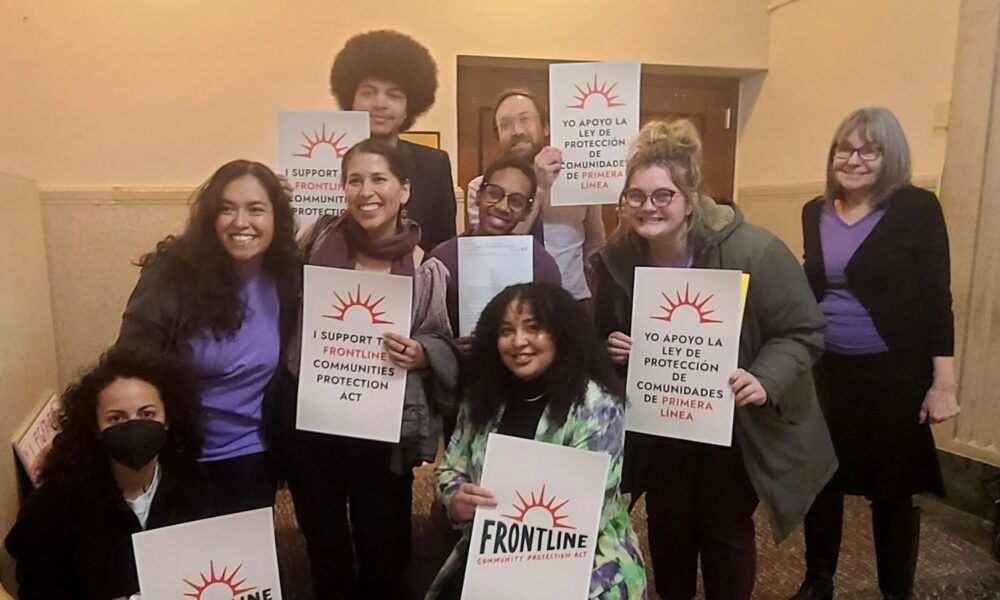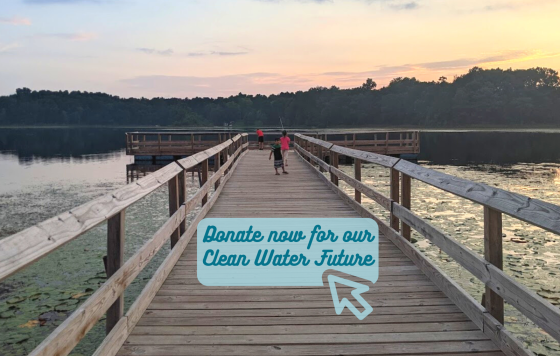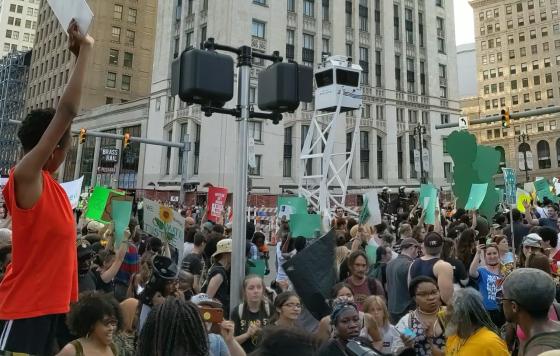Frontline Communities Protection Coalition Website

In the 2023 Minnesota legislative session, we saw the passage of an important environmental justice law: the cumulative impacts law. This piece of legislation requires the Minnesota Pollution Control Agency (MPCA) to conduct a cumulative impacts analysis for polluting facilities in or nearby marginalized communities. This analysis will look at the different sources of pollution that are in the area and impacting the local community, as well as social, environmental, health, and economic factors that may make that community more vulnerable to the impacts of pollution.
Clean Water is part of the Frontline Communities Protection Coalition, a group working to shift regulatory power to communities, and reduce pollution in overburdened communities. We helped to pass the cumulative impacts law, which will require polluting facilities to take into account local sources of pollution and community vulnerability when applying for permits, and are now working together to see through a successful implementation.
This law is currently entering into the rulemaking process, where the Minnesota Pollution Control Agency (MPCA) will clarify details of how the law will work in effect. This will be an incredibly important process to engage with, as weak rules could effectively undermine any power this law could hold.
Our regulatory system has a history of favoring corporations over people, and that has to change. This rulemaking process is an opportunity to create a law that empowers our marginalized and overburdened communities to determine for themselves if a polluting facility should be allowed in their space. We need a regulatory process that works for the people and environment.
What are cumulative impacts?
In everyday life, some people are exposed to numerous pollutants from a wide array of sources through multiple media and pathways. Chemical stressors in environmental media (air, water, land) and non-chemical stressors (e.g., social determinants of health, extreme weather events) aggregate and accumulate over time from one or more sources in the built, natural, and social environments, affecting individuals and communities in both positive and negative ways―referred to as cumulative impacts. In communities, particularly those already overburdened, disproportionate impacts can arise from unequal environmental conditions and exposure to multiple stressors. Additionally, changes in climate can exacerbate many of these disproportionate impacts. Our current regulatory system does not take this into account. For a facility to get permitted, they just have to show that they will be keeping their pollution emissions under a set amount.
History of cumulative impacts policy in Minnesota
In 2008, Representative Karen Clark worked with legislative colleagues and community members to pass a law requiring a cumulative levels and effects analysis for facilities in South Minneapolis. Although geographically limited, this law created the foundation for incorporating cumulative impacts into our regulatory system.
In 2017, the North Minneapolis based grassroots organization Community Members for Environmental Justice (CMEJ) brought forward the idea of expanding cumulative impacts legislation to a statewide scale. They worked with their state representative Fue Lee to introduce legislation that would protect marginalized communities across the state who are overburdened by polluting industries. CMEJ and North Minneapolis community members worked tirelessly to keep the bill alive until the moment its passage was possible. In 2019, COPAL and the Minnesota Environmental Justice Table began collaborating with environmental nonprofits to build momentum for passing a cumulative impacts law. In 2023, the cumulative impacts bill passed through the state legislature to become law.
2023 Cumulative Impacts Law
The cumulative impacts law that passed during the 2023 legislative session was not the fully cumulative impacts law that community members and advocacy groups envisioned. Due to only having a slim majority in the state house and senate, and pushback from moderate legislators and opposition lobbying, the final cumulative impacts law was missing several provisions. Particularly, the law was limited geographically to only impact facilities in the seven county metro area, Duluth, and Rochester.
What does the 2023 cumulative impacts law do?
Disclaimer: some details of the law will be determined in rulemaking. Rulemaking is simply the process of a state agency writing rules to clarify implementation of a law. There will be more information on this later in the document.
Here is how the 2023 cumulative impacts law works:
- The law defines environmental justice communities based on economic and racial factors, and provides those communities additional regulatory protections.
- The law covers facilities that are sited within those communities or are within one mile of an environmental justice community, and has a major source air permit or one of the larger state air permits. Whenever those facilities are seeking a new, expanded, or reissued permit, they will have to determine if they are over certain benchmarks, which will be determined in rulemaking.
- Any facility that exceeds those benchmarks will need to conduct a cumulative impacts analysis. The exact contents of the analysis will also be determined in rulemaking, but would include factors such as other nearby sources of pollution and other factors that may make members of the environmental justice community more vulnerable to pollution. The commissioner of the Minnesota Pollution Control Agency may also require a facility to conduct an analysis even if they are below the benchmarks, if there is evidence they may have an impact on an environmental justice community.
- The commissioner will then determine if the permit applicant meets the criteria for “substantial adverse impact”, which will also be determined during rulemaking.
- Facilities that meet this criteria will have two options; have their permit denied, or enter into a community benefit agreement.
- The exact details for entering into a community benefit agreement will also be determined in rulemaking. It must include at least one community meeting and the benefits must be primarily toward the environmental justice community, including non economic benefits.
- We will be advocating hard for this process to center community decision making. We want communities to be able to reject a community benefit agreement if they do not want that facility in their space.
Rulemaking:
To reiterate, a number of crucial parts of this law are yet to be determined. The rulemaking process must be finished within three years at the latest. The first half year is focused on getting initial feedback and input from communities and stakeholders. After that, the MPCA will work on an initial draft on the rules.
What rules will be written?
There are 7 rules that the MPCA will write to clarify how the cumulative impacts law will function:
- Setting benchmarks to determine when a facility is required to conduct a cumulative impacts analysis. The commissioner may still require facilities below those benchmarks to conduct an analysis, but any facility that meets any of the benchmarks will have to do a cumulative impacts analysis as part of their permit application.
- Determine what information must be included in the cumulative impacts analysis. This will be using publicly available data and looking at other sources of pollution and stressors in the community that may make them more vulnerable to pollution.
- Define conditions, criteria, or circumstances that establish an environmental or health impact as a substantial adverse impact. If a facility conducts an analysis that shows they meet these criteria, they will either have their permit denied or have to try to enter into a community benefit agreement.
- Establishing the content of the community benefit agreement and procedures for entering into a community benefit agreement. This must include at least one public meeting, and active outreach to residents of the impacted environmental justice community. The permit applicant must also show that there will be benefits to the impacted community that go beyond jobs.
- Establish a petition process and form to be submitted to the agency by environmental justice area residents to support the need for a cumulative impacts analysis. If a facility does not meet the benchmarks laid out in point one, community members can submit a petition to the MPCA, asking the commissioner to require an analysis.
- Establish a process by which Tribal government can elect to apply this section to a permit application. This allows Tribal governments to opt into the policy if they would like a facility on their land to conduct a cumulative impacts analysis.
- Establish methods for holding public meetings and handling public comments. This must include things like providing translated materials and sharing information about upcoming public meetings using multiple communication methods.
How to engage in the rulemaking process
Throughout the rulemaking process, there will be opportunities to get involved and make your voice heard. First, the MPCA is currently taking public comments until October 6th. This is the legally mandated initial request for comment, which is done before any rule drafting is done. This will be an opportunity to provide input on how you think the agency should conduct public engagement, and what kind of rules you think should be written. You can either comment directly on the Office of Administration website, or our coalition’s comment form which has a sample comment you can use.
The MPCA is also hosting 5 community meetings throughout September 2023, where they will present information about the law and rules and create space for public feedback and discussion. Here is the information for each meeting:
September 12th, 1-3pm, Virtual Facebook Event Page
September 14th, 6-8pm, St Paul Facebook Event Page
September 19th, 5-7pm, Brooklyn Center Facebook Event Page
September 21st, 6-8pm, Duluth Facebook Event Page
September 26th, 6-8pm, Rochester Facebook Event Page
We are also engaging in ongoing conversations with the MPCA during this process. If you would like to be involved in more direct communication with the agency, please contact Sasha Lewis-Norelle.
FAQs
Q: Why are certain areas being covered?
A: During the 2023 legislative session, some legislators pushed back against the idea that this law should cover the entire state. They argued that since the majority of organizations pushing for this law were from the Twin Cities, this should be a metro focused area. Many of those lawmakers didn’t want this law to possibly interfere with big industries in their districts.
Q: How does this impact Tribal nations?
A: Tribal nations are sovereign states, and so they primarily interact with federal agencies, rather than state. The Tribes will still have access to the methods and practices the MPCA develops under this law, and can ask the EPA to conduct a similar analysis.
Q: What are the most important parts of rulemaking?
A: The most important rules that will be written are the benchmarks that will determine when a facility must conduct a cumulative impacts analysis, and the process for entering into a community benefit agreement.
Q: How might this law work in practice?
A: To help illustrate how this law may work, let’s look at a theoretical example, using the East Phillips neighborhood in Minneapolis. As a disclaimer, there are important details that will be determined in rulemaking, so this may not be exactly how the final law looks. A company seeking to create a new manufacturing facility in the East Phillips neighborhood would first have to determine if they are over
Q: What does a community benefit agreement look like?
A: A community benefit agreement is a way to provide additional benefits to communities that are taking on more of a burden. Some examples of things that could be included in a community benefit agreement are local hiring/training, community investments, pollution mitigation, etc.
Download One Page Info Sheet From The Frontline Communities Protection Coalition

